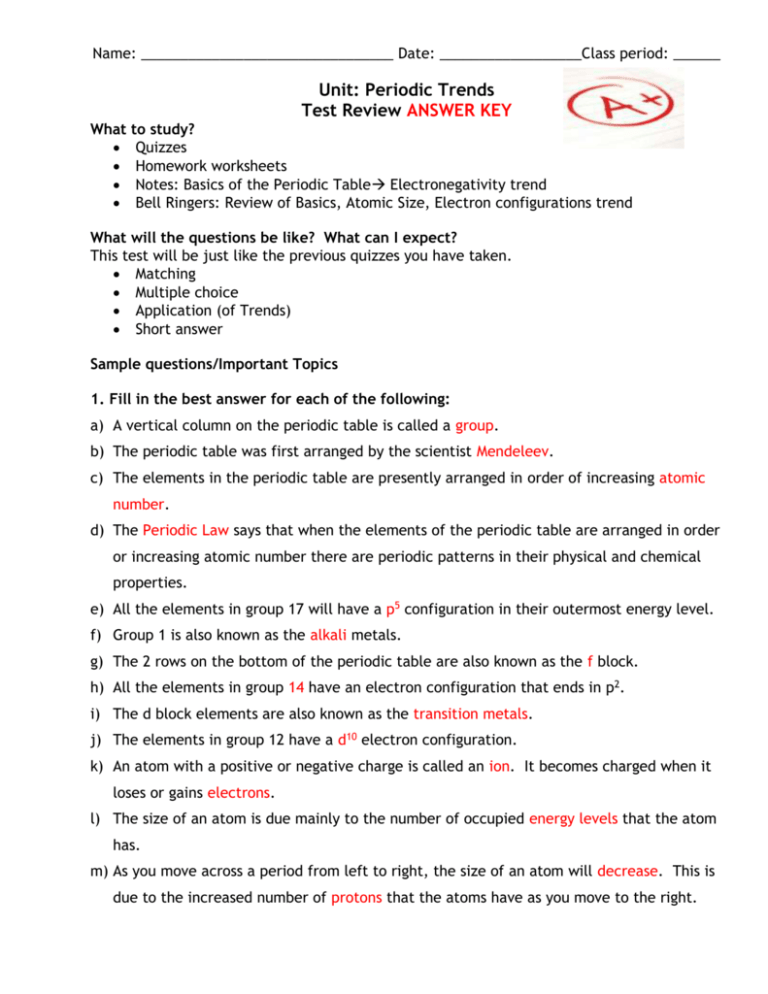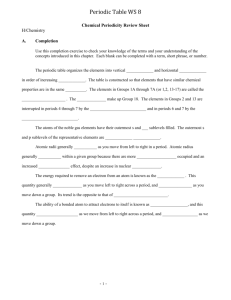Name: ______ Date: _______________Class period: ______ Unit
advertisement

Name: ________________________________ Date: __________________Class period: ______ Unit: Periodic Trends Test Review ANSWER KEY What to study? Quizzes Homework worksheets Notes: Basics of the Periodic Table Electronegativity trend Bell Ringers: Review of Basics, Atomic Size, Electron configurations trend What will the questions be like? What can I expect? This test will be just like the previous quizzes you have taken. Matching Multiple choice Application (of Trends) Short answer Sample questions/Important Topics 1. Fill in the best answer for each of the following: a) A vertical column on the periodic table is called a group. b) The periodic table was first arranged by the scientist Mendeleev. c) The elements in the periodic table are presently arranged in order of increasing atomic number. d) The Periodic Law says that when the elements of the periodic table are arranged in order or increasing atomic number there are periodic patterns in their physical and chemical properties. e) All the elements in group 17 will have a p5 configuration in their outermost energy level. f) Group 1 is also known as the alkali metals. g) The 2 rows on the bottom of the periodic table are also known as the f block. h) All the elements in group 14 have an electron configuration that ends in p2. i) The d block elements are also known as the transition metals. j) The elements in group 12 have a d10 electron configuration. k) An atom with a positive or negative charge is called an ion. It becomes charged when it loses or gains electrons. l) The size of an atom is due mainly to the number of occupied energy levels that the atom has. m) As you move across a period from left to right, the size of an atom will decrease. This is due to the increased number of protons that the atoms have as you move to the right. n) As you move down a group, the size of the atoms will increase due to a greater number of energy levels as you move down the group. o) The amount of energy required to remove the most loosely held electron from an atom is called the (first) ionization energy. p) The amount of energy required to remove a second or third electron from an atom is always more than the amount of energy required to remove the first electron. q) For Potassium (K), we would expect a large increase in ionization energy to occur when the second (2nd) electron is removed. This is because potassium will have the same electron configuration as noble gas before that electron is removed. r) Ionization energy will increase as you move across the period and decrease as you move down the group. s) The size of a positive ion is always smaller than the size of the neutral atom from which it was made. t) The size of a negative ion is always larger than the size of the neutral atom from which it was made. u) Fluorine has the highest Electronegativity with a value of 4.0. v) Electronegativity is the ability of an atom to attract electrons to itself when the atom is in a chemical bond. w) Electronegativity will decrease as you move down a group. x) The elements in group 18 do not have defined values for electronegativity. y) Electronegativity will increase as you move across a period. 2. Circle that atom with the larger atomic size: a) Mg or Ca b) Ga or Br c) N d) Rb or or As Sr 3. Circle that atom with the smaller atomic size: a) V b) Sn or Mn c) N or Si or d) Rb F or Sr 4. Circle the atom with the larger first ionization energy: a) P b) Al or S or c) K Cl or d) O Li or Te 5. Circle the atom or ion that is larger: a) F-1 b) Cr+2 or or c) Mg+2 F Cr+3 d) P-1 or Mg P-3 or 6. Circle the atom with the larger electronegativity: a) B b) Rb or In or c) C Cs d) Sn or or F Sb 7. Does Li or F have the larger atomic radius? Explain why. Li is larger because it has less protons than F. (Li’s nuclear charge does not have as strong of a pull on electrons.) 8. Arrange the following elements as described below: Same period: C, F, O Same group: K, Li, Cs a. In order of decreasing atomic size (largest to smallest) Period: C, O, F Group: Cs, K, Li b. In order of increasing ionization energy (smallest to largest) Period: C, O, F Group: Cs, K, Li c. In order of decreasing electronegativity (largest to smallest) Period: F, O, C Group: Li, K, Cs 9. Among the following pairs of atoms, identify the larger of the two, the one that requires the most ionization energy, and the one with the lower electronegativity. Atom Larger Greater ionization energy Lower electronegativity a. Li or K K Li K b. C or N C N c. Mg or Ca Ca Mg Ca d. O or S S O S 10. The outermost energy level configurations of the theoretical elements A – E are listed below. Label what element the electron configuration corresponds to. A = 3s2 B = 3s1 C = 2s2 2p6 D = 2s2 2p5 E = 2s2 2p3 Mg Na Ne F N 11. Explain why elements with high ionization energies typically also have high electronegativity values. (Fluorine for example) These elements do not want to lose electrons because they wish to obtain the same electron configuration as the noble gases. Elements on the right side of the Periodic Table (nonmetals) behave this way.






